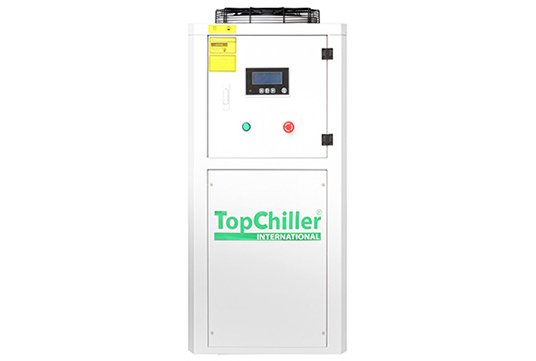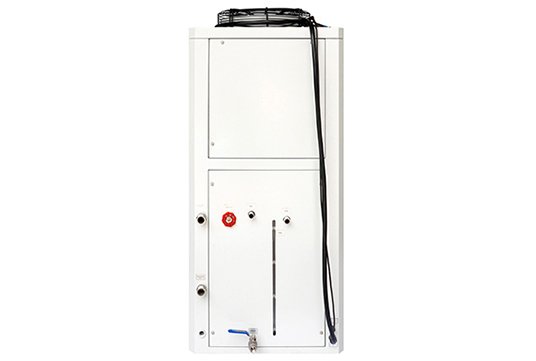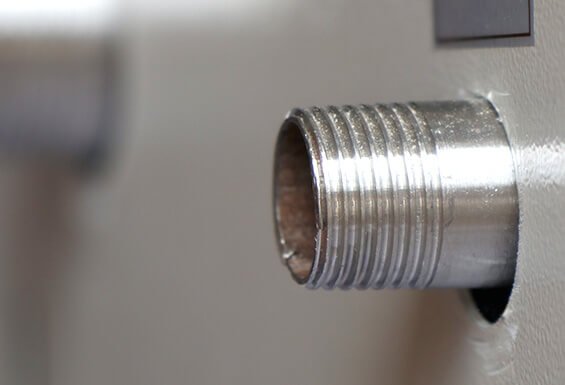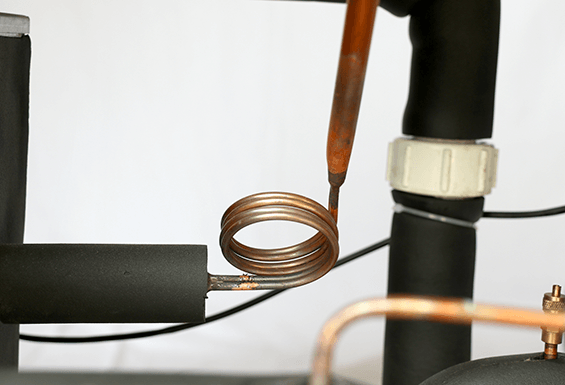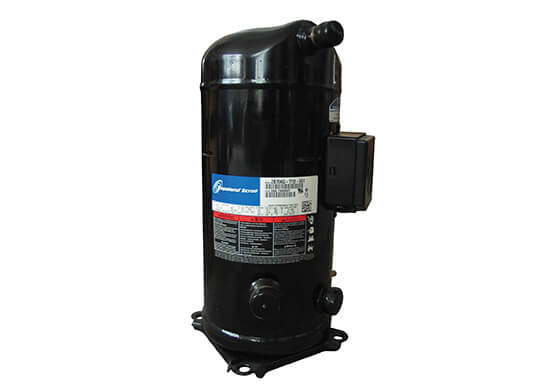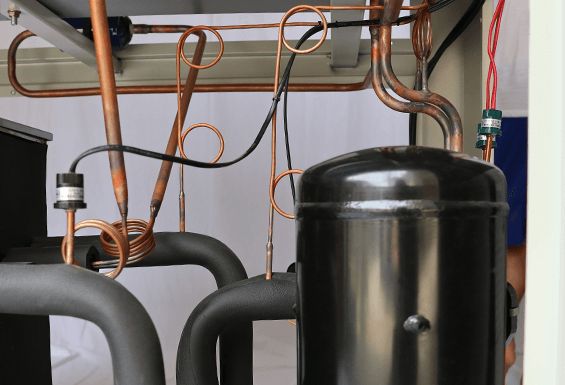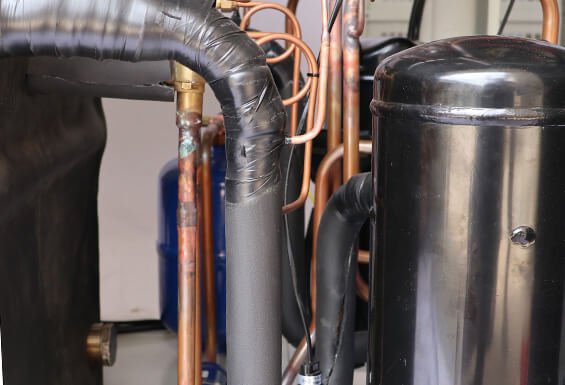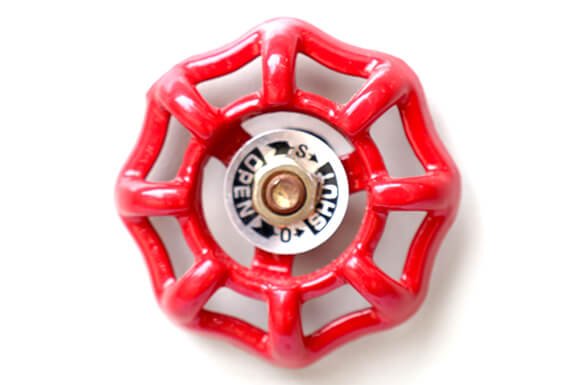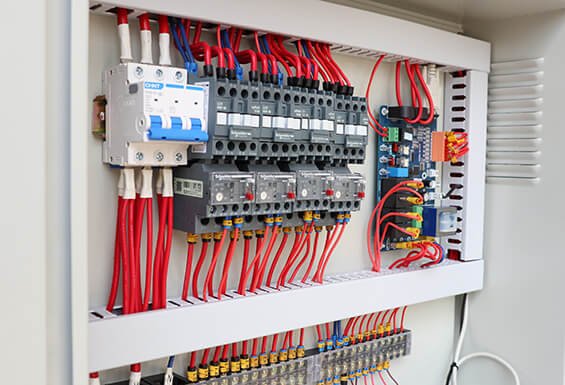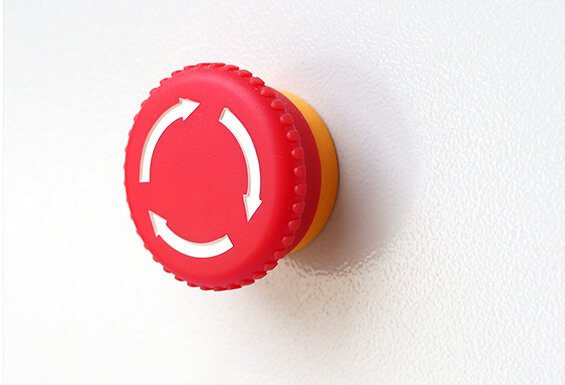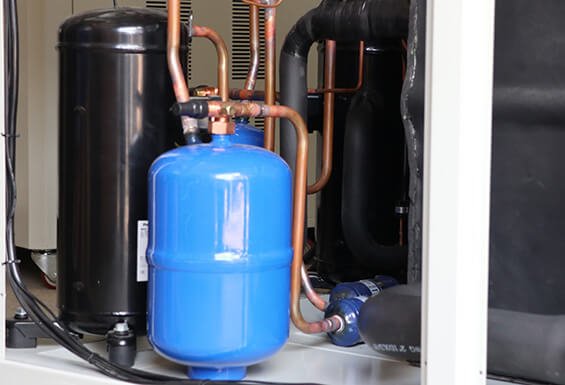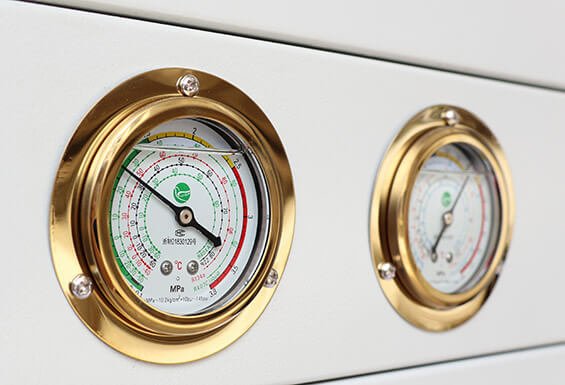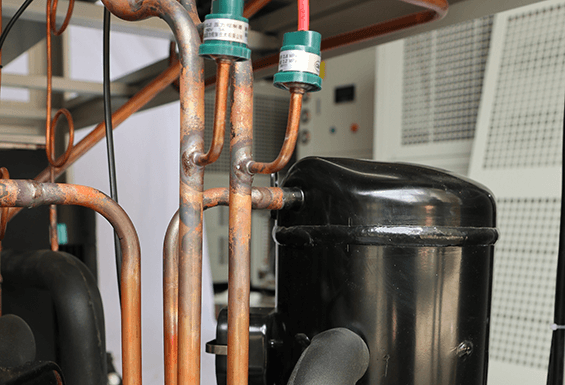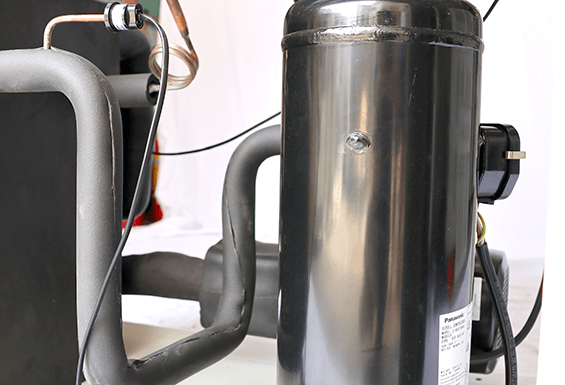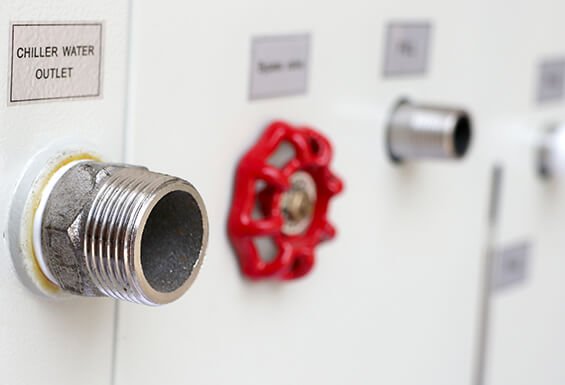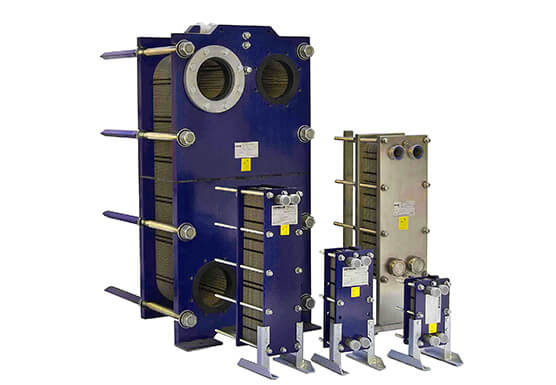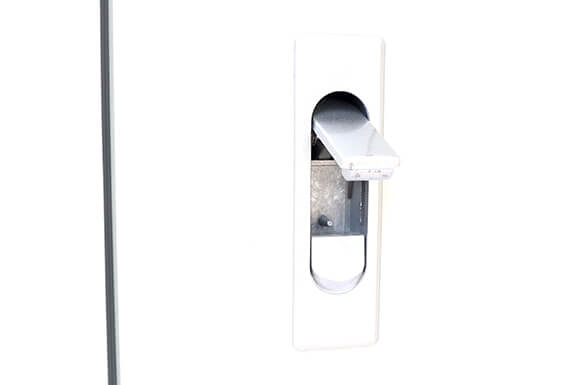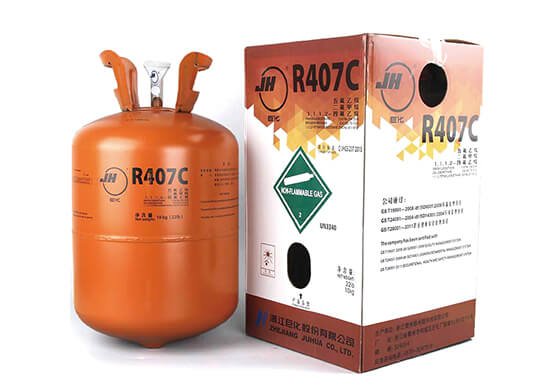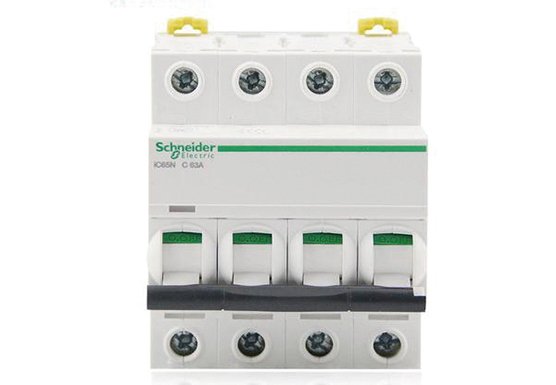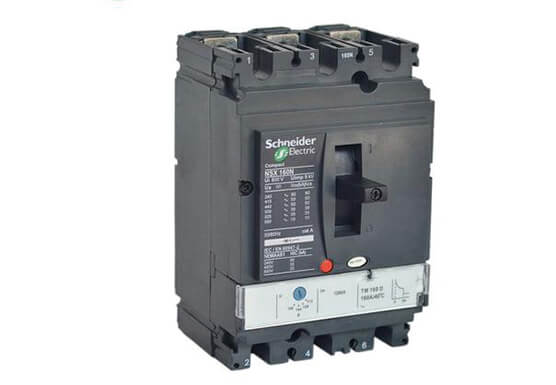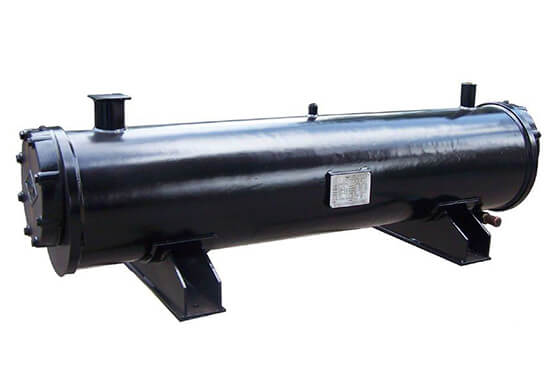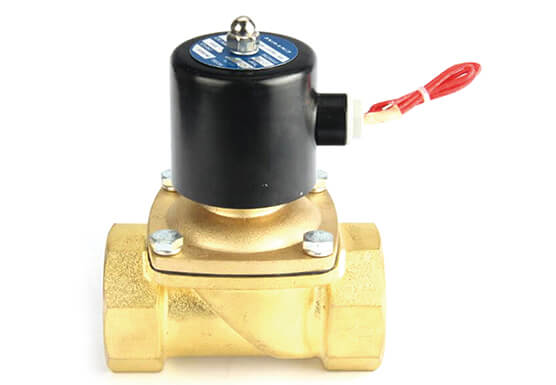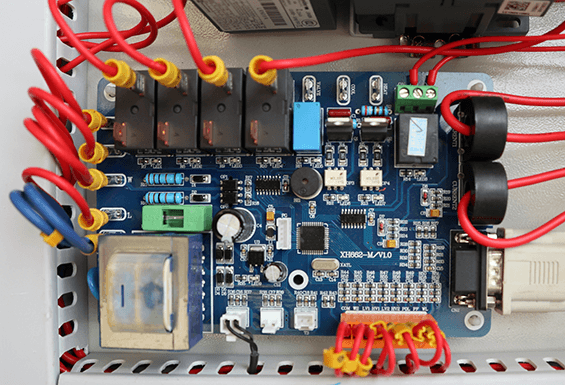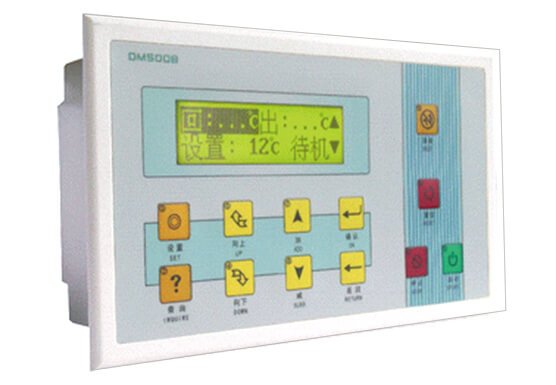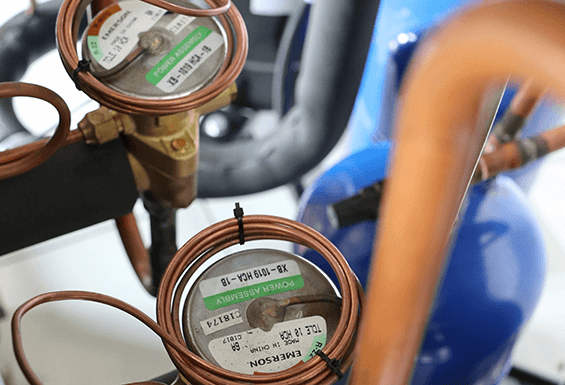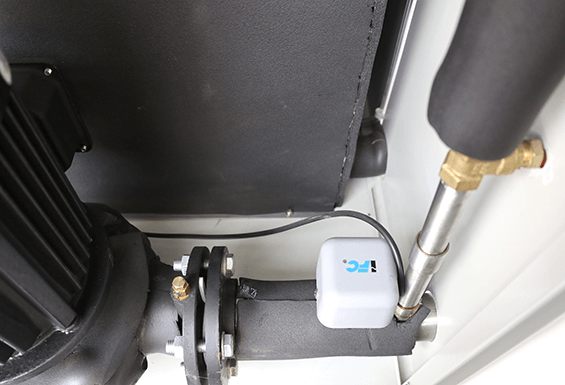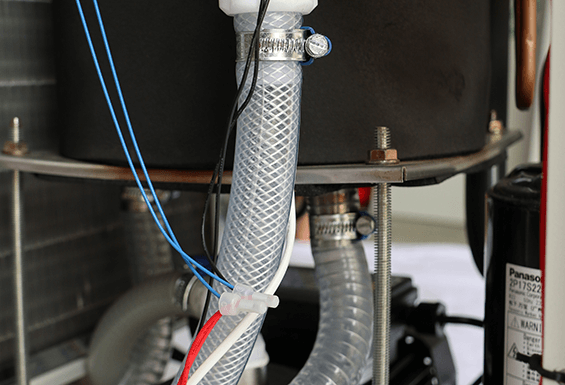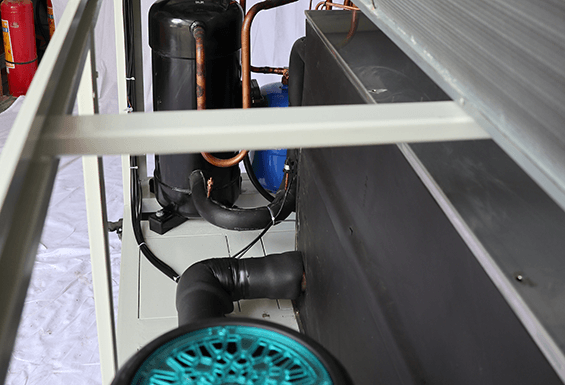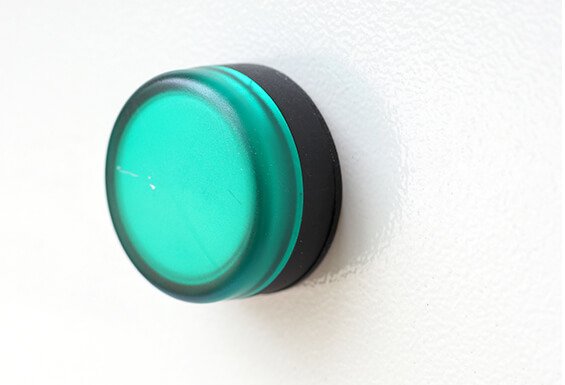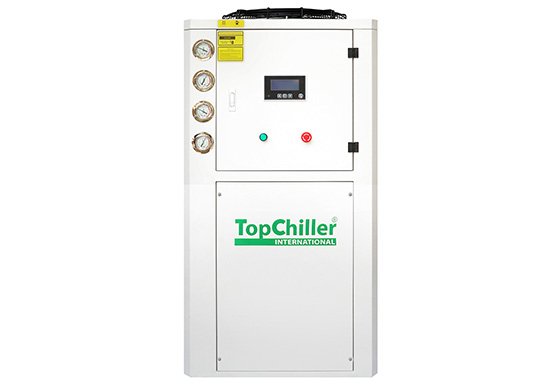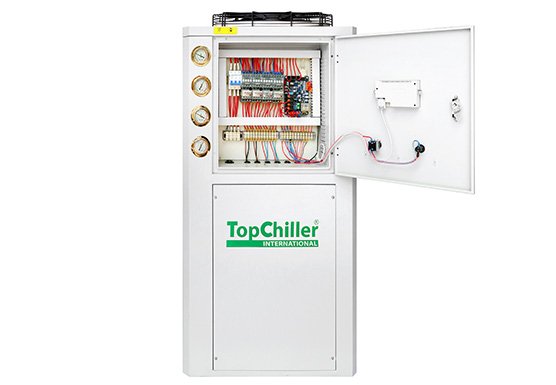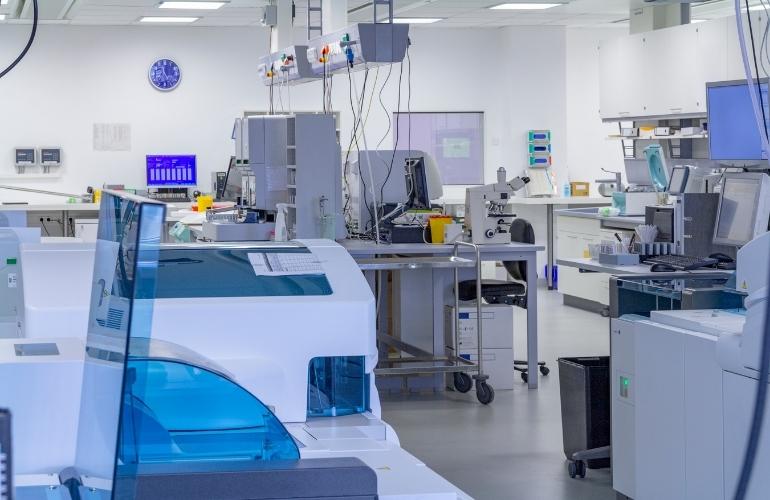TopChiller can design and manufacture all types of coolant chillers for you
- Cooling capacity ranges from 1 Ton to 50 Ton
- Temperature control ranges from 10°C to 40°C
- Reliable branded scroll type compressor
- Water tank with PUF insulation & SS pump
- Energy-efficient air/water-cooled condenser
- Chiller inlet for coolant temperature indication
- High pressure/low-pressure switches & flow meter
- Brazed plate/tube type Heat exchanger & air filter
Your Premier Hydraulic Coolant Chiller Manufacturer and Supplier Over 20 Years
A Coolant Chiller is a chilling unit that uses chilled water or air circulation around a condenser to maintain the temperature of the coolant by discharging extra heat produced during machine processing.
TopChiller is the foremost company of China that has developed long-term relationships with our customers by manufacturing energy-efficient and reliable Coolant Chiller at a large scale to meet the basic needs claimed by clients over the last twenty years.
TopChiller is profoundly manufacturing a full line of Coolant Chiller models and supplying to the whole world markets with credentials and integrity in the industrial world.
Coolant Chiller constitutes of branded scroll /screw compressor, flow meter, water tank, air/water-cooled condenser, air filters, heat exchangers, pressure switches, agitator pump, pipelines, protection devices, refrigerant tank, and electric supply circuits for performing its efficient operation.
TopChiller brand Coolant Chiller has a large number of benefits for different industrial fluid processing applications as given below:
- Coolant Chiller is highly efficient in heat dissipation of coolant during machine processing configured by the use of inbuilt pumps that enforces fluid from the tank to chiller evaporator for instant heat discharge and back transfer the fluid inside the tank to continue machine processing.
- TopChiller brand Coolant Chiller is significantly used for machines having rotating spindles to produce an instant chilling effect as spindles rotate speedily producing a large amount of heat that can be damaging for unit and spindles by chilling the coolant before circulating inside the machine.
- Coolant Chiller is assorted is versatile in its operation and can be featured beside or at above the storage tank with evaporator submerged inside tank configuring constant heat exchange between fluid and evaporator.
- An agitator pump is also featured inside the Coolant Chiller that ensures the continuous movement of fluid around the coils of the evaporator during heat exchange so that all heat from the coolant may release out steadily.
- PLC-based temperature controller senses the temperature of the fluid inside the tank and regulates it at a set point precisely.
Coolant Chiller is used for different applications at the industrial and commercial level as given below:
Die casting industry, machines tool manufacturing industry, injection molding, metal cutting as threading, broaching, drilling, medical industry, iron melting, laser industry, and semi-conductors manufacturing.
Are you sourcing for a customized and energy-efficient Coolant Chiller for your application?
Are you in search of an honorable and certified Coolant Chiller manufacturer in China for getting the best key tips and suggestions for the development of your own business?
TopChiller is a well-known company in China maintaining its integrity all over the world. Make contact with TopChiller staff and don’t feel hesitation in getting any information you may want regarding Coolant Chiller featuring pricing and specifications.
Our team is intended to provide you with the best dictation that will be beneficial to size the best Coolant Chiller for your application at affordable rates.
General Description:
The Coolant Chiller is a process chilling electromechanical device used to maintain the temperature of the coolant by eradicating the excess heat generated during machine processing. It also helps in thermal stability by reducing thermal changes and noise production.
A Coolant Chiller manufactured by TopChiller features a robust design enclosing all the necessary components required for your application. These components include a compressor, expansion valve, evaporator, expansion valve, controlling system, process pump, refrigeration circuit, etc.
Coolant Chiller designed by TopChiller is famous for carrying out various cooling processes and an efficient temperature maintaining solution. Some of the applications are in cutting, ceramic, grinding, plastic, NC grinding machines, and other material manufacturing industries.
If your application requires stabilization and maintenance of the fluid, consider TopChiller for making your purchase. You will never regret your decision by getting the most efficient solution to your process needs.
TopChiller is a famous brand of China, serving people in the market for more than 20 years. We offer a diverse range of Coolant Chiller models with versatile features to meet the application needs of a broad user range.
To get your highly efficient Coolant Chiller right now, reach out to and make the best purchase.
Features and Advantages:
A Coolant Chiller manufactured by TopChiller comes with the following beneficial features:
- A three-phase rotary compressor is installed in all models for offering maximum stability and durability. This ensures long service life with low maintenance and servicing requirements.
- Coolant Chiller mark certified by the European Conformity (EU). The high-quality digital controller installed on the unit supports multiple languages. This makes it easier to be operated by various operators, regardless of their language.
- It also comes with a diverse variety of specification options. These options include a cycle pump, level check, heater, and coolant. You can also check the fluid flow rate of the system to ensure smooth operation. It also allows you to check operation hour settings for ensuring in-time process completion.
- PLC-based temperature controller detects the temperature of the fluid and optimizes it precisely at a set point. The dynamic temperature control system of the unit has a slight constant temperature fluctuation.
- The coolant loss by evaporation is reduced in the unit. In addition, it has reduced odor and degradation of coolant for longer liquid replacement cycles. Thus, it has lowered coolant costs.
- Data Sheet
- Image Gallery
- Main Parts
- Video
| Coolant Chiller Technical Specifications | |||||||||||||||||
| Item Model | AC-0.5A | AC-1A | AC-1.5A | AC-2A | AC-2.5A | AC-3A | AC-4A | AC-5A | AC-6A | AC-8AD | AC-10AD | AC-12AD | AC-15AD | AC-20AD | AC-25AD | AC-30AT | |
| Cooling capacity | Kcal/h 50HZ/60HZ | 1419 | 2451 | 3182 | 4833 | 5848 | 7181 | 9288 | 11988 | 14534 | 18576 | 23994 | 29068 | 38270 | 49966 | 58480 | 74922 |
| 1703 | 2941 | 3784 | 5800 | 7018 | 8617 | 11146 | 14386 | 17441 | 22291 | 28793 | 34882 | 45924 | 59959 | 70176 | 89990 | ||
| KW 50HZ/60HZ | 1.65 | 2.85 | 3.7 | 5.62 | 6.8 | 8.35 | 10.8 | 13.94 | 16.9 | 21.6 | 27.9 | 33.8 | 44.5 | 58.1 | 68 | 87.2 | |
| 1.98 | 3.42 | 4.4 | 6.74 | 8.2 | 10.02 | 12.96 | 16.73 | 20.28 | 25.92 | 33.48 | 40.56 | 53.4 | 69.72 | 81.6 | 104.64 | ||
| Input power | KW | 0.88 | 1.35 | 2 | 2.25 | 2.66 | 3.27 | 4.07 | 5.75 | 6.45 | 8.25 | 11.5 | 12.9 | 17.45 | 21.73 | 25.4 | 33.1 |
| Max Current | A | 5.4 | 8.2 | 12 | 13.6 | 6.6 | 8.2 | 10.1 | 13.8 | 15.5 | 20 | 27.9 | 31.3 | 42.4 | 52.7 | 63.7 | 80.2 |
| Power source | 1PH~220V/3PH~220V/380V 50HZ/60HZ | 3PH~380V/415V/480V~50HZ/60HZ(3PH~200V/220V 50HZ/60HZ) | |||||||||||||||
| Refrigerant | Type | R22/R407C/134a/404A/410A | |||||||||||||||
| Control | Capillary / thermostatic expansion valve | ||||||||||||||||
| Compressor | Type | Hermetic Rotary | Hermetic scroll ( piston ) | ||||||||||||||
| Power(KW) | 0.45 | 0.89 | 1.3 | 1.73 | 2.1 | 2.7 | 3.5 | 4.55 | 5.25 | 3.5×2 | 4.55×2 | 5.25×2 | 7×2 | 8.96×2 | 10.8×2 | 8.96×3 | |
| Condenser | Type | Efficient finned copper tube with aluminum+low noise external rotor fan | |||||||||||||||
| Air flow (m³/h) | 750 | 1000 | 1500 | 2000 | 2500 | 3000 | 4000 | 5000 | 6000 | 8000 | 10000 | 12000 | 15000 | 20000 | 25000 | 30000 | |
| Air blower(KW) | 0.06 | 0.09 | 0.15 | 0.15 | 0.19 | 0.14×2 | 0.14×2 | 0.19×2 | 0.19×2 | 0.25×2 | 0.45×2 | 0.45×2 | 0.6×2 | 0.78×2 | 0.78×2 | 0.42×6 | |
| Evaporator | Type | SS Tank coil / shell and tube type / Plate type heat exchanger | |||||||||||||||
| Chilled water (m³/h) | 0.28 | 0.49 | 0.64 | 0.97 | 1.12 | 1.44 | 1.86 | 2.4 | 2.91 | 3.71 | 4.8 | 5.81 | 7.65 | 10 | 11.69 | 15 | |
| 0.34 | 0.59 | 0.76 | 1.16 | 1.4 | 1.72 | 2.23 | 2.88 | 3.49 | 4.46 | 5.76 | 7 | 9.18 | 11.99 | 14.03 | 18 | ||
| Water tank(L) | 10.6 | 18.3 | 27 | 27 | 50 | 50 | 60 | 60 | 110 | 120 | 200 | 200 | 270 | 350 | 350 | 420 | |
| Inlet/outlet pipe (inch) | 1/2″ | 1/2″ | 1/2″ | 1/2″ | 1″ | 1″ | 1″ | 1″ | 1″ | 1-1/2″ | 2″ | 2″ | 2″ | 2″ | 2-1/2″ | 2-1/2″ | |
| Water pump | Power (kw) | 0.37 | 0.37 | 0.37 | 0.37 | 0.37 | 0.37 | 0.37 | 0.75 | 0.75 | 0.75 | 1.5 | 1.5 | 2.2 | 2.2 | 2.2 | 4 |
| Max lift(m) | 22 | 22 | 22 | 22 | 22 | 22 | 22 | 30 | 30 | 25 | 25 | 25 | 28 | 28 | 28 | 30 | |
| Max flow (m3) | 5.4 | 5.4 | 5.4 | 5.4 | 5.4 | 5.4 | 5.4 | 8.1 | 8.1 | 8.1 | 13.5 | 13.5 | 25.2 | 25.2 | 25.2 | 36 | |
| Safety protection | Compressor inner protection, over current protection, high/low pressure protection, over temperature protection, flow rate protection, phase sequence/phase missing protection, low level coolant protection, anti freezing protection, exhaust overheat protection | ||||||||||||||||
| Dimension | L(mm) | 500 | 560 | 600 | 600 | 720 | 850 | 980 | 1100 | 1180 | 1450 | 1530 | 1530 | 1650 | 1850 | 1900 | 2250 |
| W(mm) | 350 | 420 | 420 | 480 | 550 | 580 | 520 | 580 | 620 | 750 | 750 | 750 | 910 | 1000 | 1050 | 1400 | |
| H(mm) | 600 | 720 | 770 | 910 | 1350 | 1030 | 1170 | 1350 | 1350 | 1500 | 1630 | 1630 | 1740 | 1850 | 1970 | 1950 | |
| Net weight(KG) | 45 | 70 | 85 | 95 | 125 | 150 | 175 | 195 | 220 | 285 | 350 | 370 | 510 | 630 | 820 | 950 | |
| Note: The above specifications are according to the following design conditions: 1, 12℃/7℃.Chilled water inlet/outlet temperature 12℃/7℃. 2, 33℃/38℃.Cooling air inlet/outlet temperature 33℃/38℃. We reserve the right to modify the specification without further notice. | |||||||||||||||||
Why TopChiller is Your Reliable Coolant Chiller Manufacturer and Supplier In China?
Coolant Chiller-An Ultimate FAQ Guide by TopChiller.
- What is a Coolant Chiller?
- What are the Major Features of a Coolant Chiller?
- What are the Significant Components of a Coolant Chiller?
- How Does the Coolant Chiller Work?
- What are the Advantages of a Coolant Chiller for your Industry?
- What are the Applications of a Coolant Chiller?
- How Does High Temperature Affect your Coolant Chiller?
- What is the Most Suitable Refrigerant for your Coolant Chiller?
- What are the Optional Features of a Coolant Chiller?
- What is Dip in Type Coolant Chiller?
- What is a Stand-Alone Type Coolant Chiller?
- What are the Different Compressor Systems for your Coolant Chiller?
- What Makes a Coolant Chiller Durable?
- How to Install a Filter in your Coolant Chiller?
- How to Estimate the Cooling Capacity of your Coolant Chiller?
- How to Maximize the Efficiency of your Coolant Chiller?
- How to Solve the Problems of your Coolant Chiller?
What is a Coolant Chiller?
A Coolant Chiller is a soothing device that monitors and stabilizes the temperature of the coolant by eliminating the extra heat absorbed by it during machine processing.
The maintenance of the cooling temperature of the coolant is crucial for maximum working of the chiller. An electromechanical process is used for this purpose.
The chilled coolant is then circulated in the chiller to offer maximum heat exchange. The lower the coolant temperature, the greater the heat transfer because of the increased temperature difference.
It reduces the vibrations and noises produced by thermal changes and also increases thermal stability.
Coolant Chiller is primarily used in water-soluble coolants used for grinding and cutting. NC grinding machines, plastic industry, ceramic industry, and other material synthesizing industries use it for added thermal stability and higher efficiency.
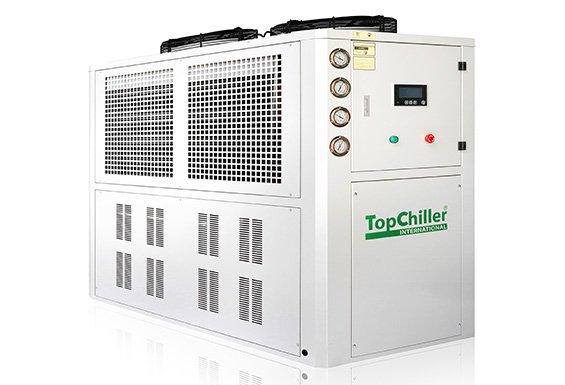
Coolant Chiller Designed by TopChiller
What are the Major Features of a Coolant Chiller?
Coolant Chiller has different features for carrying trouble-free and convenient applications. These features include:
- At 70-90° F, +/- 1° ambient temperature
- Setpoint and ambient live temperature monitoring
- Comes with the installation kit
- Includes filtration system and supply pump
- 460V/480V and 208V/230V voltage options
- Open-loop chiller
- No heat exchanger clogging with standard filtration
- No requirement of adding refrigerant or replacing the compressor
- Controllable auto-shutdown feature
- Large capacity quick change filtration
- 5 micron, dual filter
What are the Significant Components of a Coolant Chiller?
Control Panel
The primary purpose of the control panel is to control and operate your Coolant Chiller, including the starting up, maintenance settings, or powering off.
Pneumatic System
The pneumatic system is installed to manage and properly control the pressure within the unit.
Its strong connection with the control panel enables the user to operate the pressure system efficiently.
Electronic Unit
The electric unit supplies the energy or power for this whole cooling system to work. This power is adjustable with the help of different parts of the electric unit.
Refrigeration Unit
The refrigerant unit is responsible for supplying the refrigerant, which has one of the significant roles in absorbing extra heat.
You will find a refrigeration tank in the refrigeration unit, which holds up the reservoir refrigerant.
Compressor
Compressing the refrigerant is done by the compressor, allowing it to move quickly at high speed.
Centrifugal, screw, and scroll compressors are commonly used compressor types used in Coolant Chillers.
Condenser Unit
The condenser unit deals with heat dissipation while the refrigerant is turned into a liquid from the gaseous state.
The refrigerant comes into direct contact with chilled air currents or water currents. The heat from the refrigerant is absorbed as it flows through the coils.
This heat can be later transferred to the environment or can be used for any other process.
Evaporator
The heat that has been removed from the coolant can be used here for converting the liquid refrigerant into a gaseous form.
The surface area of the evaporator must be more significant. It allows greater evaporation as the surface molecules are more in number, and they tend to break free from the rest of the refrigerant as they gain energy.
Expansion Valve
The speed and pressure of the refrigerant have to be controlled so that it can be managed and fed to the system according to the requirement.
It allows the proper use of the refrigerant for maximum advantage.
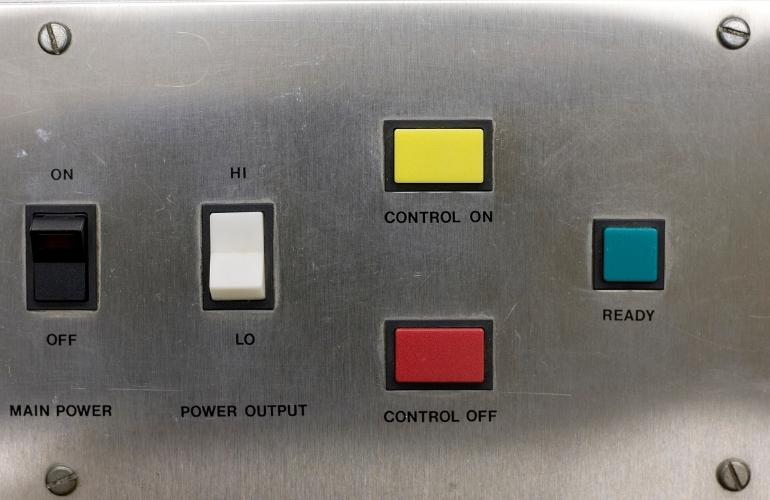
Coolant Chiller Control Panel
How Does the Coolant Chiller Work?
The Coolant Chiller has a cyclic working mechanism that is repeated to obtain the highest efficiency and allow minimum refrigerant usage.
The working mechanism consists of several phases, which are explained below:
Preparation Phase
This phase ensures that the chiller is in the optimum working stage. It is done by checking all the connections and inspecting all the components to see if they are in place.
You must check the refrigerant level in the reservoir to ensure proper supply throughout the cycle.
Now you have to set the values on the control panel according to the requirement of your application.
The temperature, pressure, humidity, and other external conditions must be maintained, and therefore you should set a narrow range for these quantities.
Once you are sure about all the preparations, press the start button to initiate the release of the refrigerant from the reservoir.
Compression of the Refrigerant
As the refrigerant flows from the storage tank to the compressor, high pressure is applied to reduce the volume. It also decreases the intermolecular spaces between the molecules.
In this way, you can increase the velocity of the molecules to direct them into a specific orientation. Various compressors with particular properties can be used in a Coolant Chiller.
Absorption of Heat
The high-velocity refrigerant flows around the pipes and tubes under high pressure. These tubes contain hot water, which has become hot due to the heat transfer from the coolant of the chiller.
The residence time of the refrigerant is increased in the evaporator as it absorbs heat and converts from a liquid to a gaseous state.
Elimination of Heat
When the refrigerant has had enough heat loads, it starts flowing directly to the condenser from the evaporator.
Cold water and air currents flow in direct contact with the refrigerant in the condenser. The temperature difference allows maximum heat transfer.
As the refrigerant has lost the heat, it converts back into a liquid state. The conversion of gas into a liquid is called condensation.
Refrigerant Setting
The velocity and press of the refrigerant must be controlled as it flows through the system.
The expansion valve allows you to brain this function by releasing only a certain amount at one time, that too, with the set pressure and speed.
The whole cycle runs again when the refrigerant directly goes to the compressor in substantial parts.
What are the Advantages of a Coolant Chiller for your Industry?
Some of the significant advantages of a Coolant Chiller are listed below:
Standard Setup
It will aid in maintaining temperature and pressure and maintaining the desired level of water in standard design.
To monitor and check the temperature, pressure, and water level, you can use its easy display option.
Quick Action
The Coolant Chiller quickly reacts by correcting the change whenever any temperature change occurs.
By using this chiller, you can easily and quickly get rid of any unwanted temperature changes.
High-Grade Parts
Due to the high quality of its components, it lasts much longer than other comparable products.
Corrosion Resistance
All the components have strong corrosion resistance plus can survive harsh weather easily. This is due to high resistance stainless steel and other materials used in manufacturing these components.
Efficient Circulating Pumps
The efficient and high-pressure circulating pumps allow you to maintain the required pressure in a minimum time.
This will help in a considerable increase in the flow rate of this chilling system.
What are the Applications of a Coolant Chiller?
The applications of a Coolant Chiller include the following:
- Medical Industry
- MRI Machines
- CT Scan
- Medical Laboratories
- Research Laboratories
- Manufacturing Processes
- Iron Smelting
- Molding
- Welding
- Laser
- Semiconductor Industries
Coolant Chiller Applications
How Does High Temperature Affect your Coolant Chiller?
The high temperature for long hours can negatively affect your Coolant Chiller and dramatically affect efficiency. Here are a few ways in which it causes damage to the system:
Scrapped or Rejected Components
High temperatures tend to melt the sensitive parts of the components made up of any low melting point material.
With these parts melting, the components lose their function and directly affect the chiller’s efficiency as they disrupt the refrigeration cycle.
Reduction in Service Life
High temperatures decrease the chiller’s service life by denaturing the main components.
The valves and the tube network also undergo degradation leading to a lag in the normal flow.
Wastage of Resources
If the coolant is exposed to high temperatures for long hours, it might evaporate. It is impossible to restore all the evaporated coolant, which gets wasted.
Wear and Tear
Due to high temperatures, the system parts that run against each other tend to wear out and lose their function.
The shape and architecture details are lost, and therefore the function is not performed correctly.
What is the Most Suitable Refrigerant for your Coolant Chiller?
There is a wide variety of refrigerants that can be used in a Coolant Chiller. However, the most preferred and widely used is glycol.
Glycol is a water-soluble compound with excellent dissipation properties and high heat absorption.
The mixture of glycol is more efficient than the glycol alone. It goes well with the properties of a suitable refrigerant which are as follows:
- It must not damage the ozone layer like the chlorofluorocarbons.
- It shall be environmentally friendly.
- The cost should be within the range of the user.
- It shall have no adverse effects on the system.
- There should be the maintenance of a proper refrigerant level in the system.
What are the Optional Features of a Coolant Chiller?
There are various optional features that you can install in your Coolant Chiller to improve its functioning.
Customization also helps in optimizing your chiller according to your application need.
This results in energy-saving, affordable, highly efficient, and durable operation. Some of these optional features include:
- Process Machine Interfacing Devices
- Optional Monitoring Systems
- Microprocessor-Based Chiller Controller
- Filters
- Non-Standard Voltages and Frequencies
- Refrigerant Gauges
- Hot Dipped Tinned Evaporators
- Meter
- Pressure Relief Valve
- Chiller Inlet Coolant Temperature Indicator
- Solenoid Valve
- Variable Frequency Drive
- Flowmeter
- An Optional Hot Gas Bypass
- Optional Monitoring Systems
- Audio and Visuals Signals
- Large Coolant Reservoir
- Flow Switch
- Additional Interlocks Apart From High-Temperature Alarm
- Hot Gas Bypass
- Remote Control Panel
- Check Valve
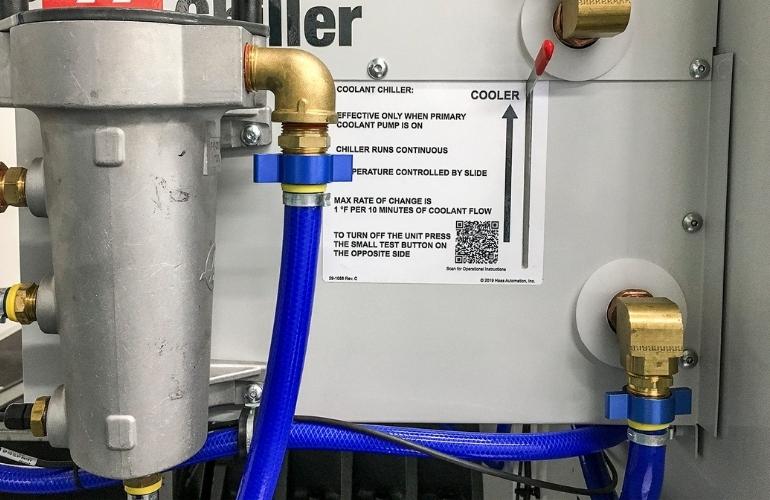
Coolant Chiller Filter
What is Dip in Type Coolant Chiller?
A Dip type of Coolant Chiller is specially designed for being installed on the top of the tank. It then cools the fluid that moves through the tank.
It comes with an already installed immersion coil type evaporator with stainless steel construction. This evaporator is submerged inside the fluid-filled tank.
You can also install a small agitation pump in your Coolant Chiller for the continuous movement of the fluid around the coils. As a result, the heat transfer process is carried out uniformly.
The temperature controller senses the temperature of the fluid-filled in the tank. This helps in controlling the refrigeration effect, which leads to the maintenance of the required temperature of the fluid.
Dip-in-type design construction has gained more popularity because they help with considerable space-saving.
This makes them best to be installed on tanks with containments-filled coolant. Containments can include muck, chips, etc.
You can periodically clean the evaporator coils simply by lifting up the unit from the tank.
Some great features offered by this type include:
- It can be easily relocated and mounted anywhere depending on the requirements
- Highly flexible operation
- Capacity deciding coil designing, no extraordinary lengths required
- Control valves work for closer temperature tolerance
- Independent and easy coil replacement
- Helps in reducing the contamination potential of the coolant
- Easy maintenance and servicing
- Cost-saving than integrated drop-in designs
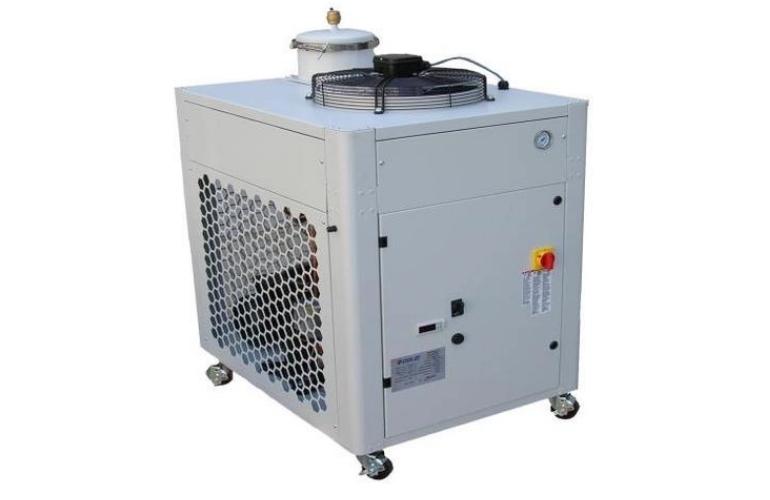
Dip in Type Coolant Chiller
What is a Stand-Alone Type Coolant Chiller?
In a Stand-Alone Type Coolant Chiller, an inbuilt pump is already installed. The function of this pump is to remove fluid from the coolant tank that is present remotely.
This happens when this pump gains energy. Next, it pumps the fluid back to the tank by passing it through the evaporator installed in the unit.
In the next step, the temperature of the fluid making its way inside the chiller is sensed by the temperature controller. This controller also works for controlling and maintaining the refrigeration effect.
As a result, it helps maintain the required temperature of the fluid present inside the tank. It would be best to consider here that you must install the cooler nearest to the tank.
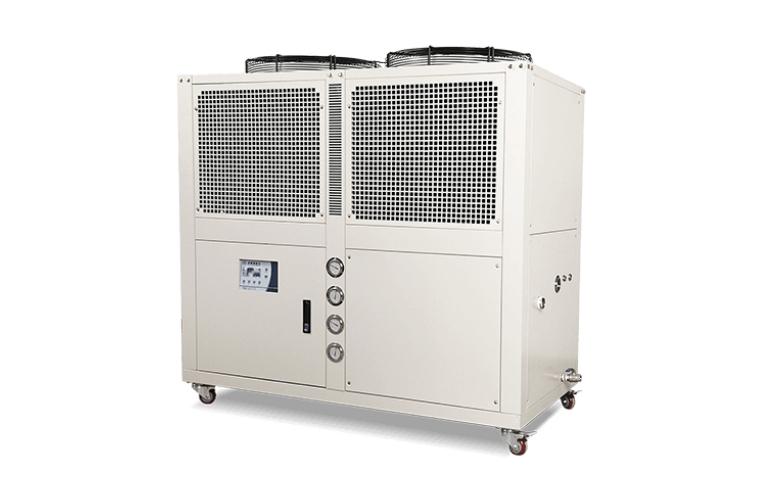
Stand-Alone Type Coolant Chiller
What are the Different Compressor Systems for your Coolant Chiller?
The primary function of installing a compressor in your Coolant Chiller is to lower the volume of the gas and increase its pressure.
It helps transport the fluid through the pipes and reduces fluid pressure.
Low temperature and low pressure of the fluid are achieved by removing vapors from the evaporator before sending the fluid to the condenser.
In the case of a Coolant Chiller, you have three different options for choosing the best compressor system.
The essential function of all these compressors is the same, but there is a slight variation in their construction and working mechanisms.
Scroll Compressor
There are orbiting as well as fixed scrolls involved in the main construction of this compressor.
The purpose of installing both these scrolls is to help efficient refrigerant compression. These compressors are best to be used in applications in schools, offices, and clinics.
Screw Compressor
Next comes the screw compressor, which involves the installation of two rotors for its working.
These rotors help compress the refrigerant and turn it into a high-pressure liquid from a low-pressure one.
The essential purpose of these rotors, also called screws, is to entrap the refrigerants before converting high-pressure refrigerants.
Centrifugal Compressor
As the name says, a centrifugal compressor uses the principles of centrifugal force for the compression of refrigerants.
The ideal situations for using a centrifugal compressor include medium to high capacity applications.
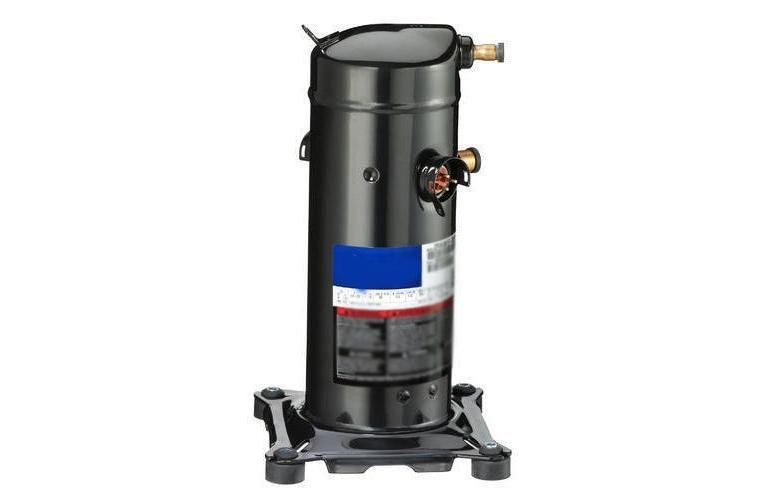
Coolant Chiller Scroll Compressor
What Makes a Coolant Chiller Durable?
The following factors are involved in improving the durability of a Coolant Chiller:
Heavy-Duty Components
All the components are protected in their own way from various sudden damages and weather attacks.
They are composed of corrosion-resistant substances that protect them from corrosion for a long time. Thus, improving the durability of the unit.
Heat Absorption Properties
Stainless steel also can absorb heat effectively and help cool the coolant. It also helps in the disposal of heat from the machining device.
High Tensile Strength
Various components of the unit are made up of stainless steel that stabilizes its structure even with intense exposure to extreme temperature and high pressure.
Protection Devices
The Coolant Chiller is equipped with various protection devices that protect the unit from instant damages. They protect line with their specific functioning.
How to Install a Filter in your Coolant Chiller?
Drag the coolant filter assembly towards the screws of your unit and fix it properly. Then, make sure that all the barb fittings are covered with hose caps.
Now, connect all the coolant hoses as mentioned in the instruction manual. You can use hose clamps to perfectly secure the barb fittings with a hose cap.
If the hose cannot reach the barb fitting, you can establish a jumper hose using a dual-sided hook fitting. It is essential to provide some slack for every hose to prevent kinking.
The following are some connections you need to make while fitting this coolant filter:
- Bring the coolant hose to the filter assembly from the pump.
- Link the heat exchanger with the filter assembly.
- Using the cable carriers placed beneath the Coolant Chiller, join the filter assembly with the waycover washdown. You can use a cable clamp to perfectly secure the waycover washdown hose.
- Ensure that you also attach the temperature sensor cable and this waycover washdown hose.
- Now, bring the coolant hose from the washdown spray nozzle to the filter assembly.
- Finally, attach the heat exchanger to the flood coolant.
- After establishing all these connections, the filter in your Coolant Chiller is ready to be used.
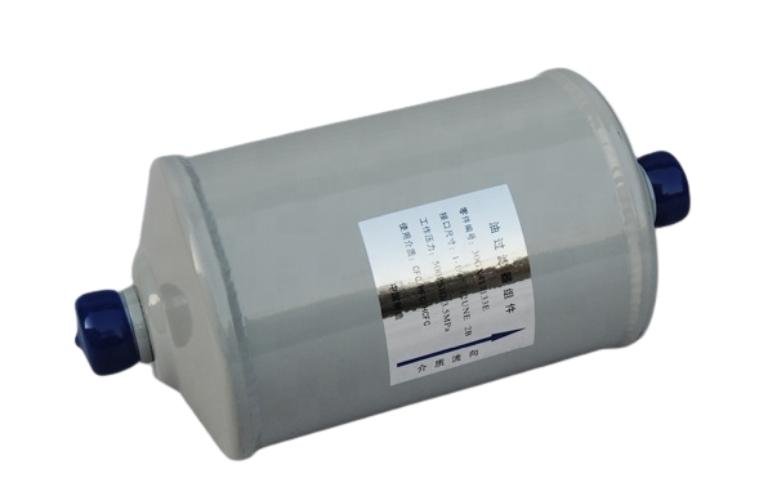
Coolant Chiller Oil Filter
How to Estimate the Cooling Capacity of your Coolant Chiller?
The cooling capability of a Coolant Chiller is its capability to get rid of excess heat from the machining processes to maintain its temperature.
The cooling capacity measurement is a critical factor you must consider while getting a chiller. It aids you in determining the precise size of a Coolant Chiller for your application that enables you to obtain the required cooling effect.
Although the S.I. system is the watt, cooling capacity is generally measured in BTUs.
Firstly, you need to compute the inlet temperature and the required temperature of the cooling medium.
Then calculate the flow rate of water per hour (m³/hour).
Finally, you will be able to estimate the cooling capacity for your Coolant Chiller by putting the calculated values in the following formula:
Tons of cooling capacity = rate of water flow x differential temperature ÷ 0.86 ÷ 3.517.
How to Maximize the Efficiency of your Coolant Chiller?
An efficient Coolant Chiller always provides you with maximum performance, giving you high output with consuming low input. This adds more to the user experience and saves energy, time, and budget.
Here are some great ways that will help you with maximizing the efficiency of your Coolant Chiller:
Maintaining Proper Records
You should always make sure to maintain regular operation records, which will help you with proper referencing.
This way, you can know if your chiller’s performance has increased, decreased, or stayed the same. As a result, you will be better able to identify problems and solve them timely.
Performing Regular Inspection
Regular inspection is necessary to locate problems causing reduced performance and inefficient operation.
As a result, you will replace any damaged components to improve efficiency timely.
Performing Regular Maintenance
Regular maintenance is also essential to prevent any more significant losses and replacements.
For this, you need to ensure that the unit is well-lubricated and clean, which will help in increasing its efficiency.
Use High-Quality Inputs
It is essential to use high-quality inputs to get maximum quality outputs. Always remember you will get the same operation results as you will treat your Coolant Chiller.
For this reason, pay special attention to the coolant quality. It should be compatible and efficient.

Maintain Regular Operation Records of Coolant Chiller
How to Solve the Problems of your Coolant Chiller?
It is crucial to promptly solve your Coolant Chiller problems to prevent significant and permanent losses.
This section will get to know different chiller problems and the best solutions to their treatment.
- Power Failure
If your equipment stops operating instantly, operates very inefficiently, or does not even start, there might be a power failure. This is caused by damage to the power source and the connecting cables.
Solution
Replacing the broken power cords and attaching a new power source will help solve this problem.
- Leaks and Blockages
You might have to experience fluid leaks or blockages when operating a Coolant Chiller. Leakages might be caused by damage to the fluid-carrying lines or the storage tank. Accumulation of dirt can cause blockage problems.
Solution
A solution to leaks is installing a new fluid tank and replacing the fluid-carrying pipes. Blockages can be treated by thorough cleaning.

Coolant Chiller Maintenance
